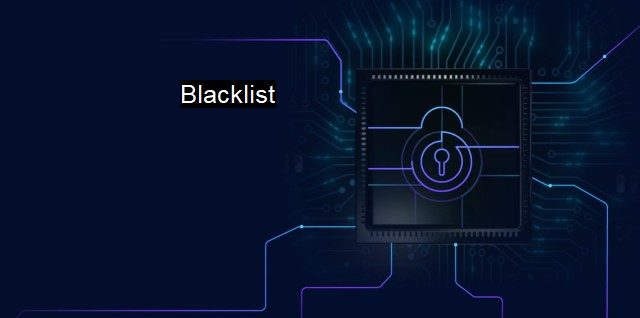What is Blacklist?
Demystifying Blacklists: Exploring their Role in Cybersecurity and Antivirus Protection
Blacklist is a basic method used to protect computer systems and networks from potential threats. This term refers to a catalogue of entities, such as malicious IP addresses, web pages, applications, email addresses, programs, or users, that are denied access to a computer, system, or network due to perceived harmful activities.This principle of cybersecurity involves perusing incoming software, code, or access requests against a predefined list of unacceptable entities, known as a blacklist. The tally can include URLs known to contain malware, spam email addresses, and disreputable software or applications that may harm the system integrity or user's data.
Anti-virus and anti-malware software often use blacklisting in their operation, equipping themselves with a frequently updated list of harmful, malicious, or suspicious files, programs, and IP addresses. These antivirus programs scan the system and compare encountered objects to those elements found in their blacklist. If any of the inspected objects matches an entity in the blacklist, the antivirus program or firewall will block it from further action, quarantining it or removing it from the system entirely. those internet security software apps provide alerts to the user whenever it detects a blacklisted object or activity.
Blacklists are invaluable in exposing commonly known threats. Since most cyber threats have unique signatures, using a blacklist enables rapid detection of malicious entities. Internet security companies maintain large databases containing signatures of known viruses, malware, and other threats. Through frequent updates, these databases monitor recent, emerging cyber threats around the globe. This essential security tool aids cybersecurity experts in preempting threats and strengthening defense mechanisms.
Relying on blacklists alone is insufficient in ensuring cybersecurity. Blacklists are most effective in identifying and combating known threats but fall short against new, unrecognized threats. The primary weakness of blacklist-based antivirus approach is its inability to recognize new malware or security threats that are not listed in its database. This loophole allows new forms of cyber-attack to penetrate the defense, potentially leading to critical data breaches or harming the system.
Blacklists need constant updates as cyber threats continuously morph. Attackers constantly craft new methods and entities to challenge existing security protocols. Rogue developers can change a line or two of malware coding to disguise the harmful program from being blacklisted danger. This modified code is ancestrally related to the blacklisted code but appears unique. Therefore, a system reliant only on blacklist measures could be taken aback by these disguised threats.
Despite the limitations, blacklists are an integral component of cybersecurity essential in warding off known threats. It allows users to protect their systems from known malicious entities and untrusted sources that could potentially compromise their data security. They work in combination with other cybersecurity strategies like whitelisting and heuristics to provide comprehensive security from a diverse range of threats, both new and old.
Hence, a future-proof cybersecurity strategy goes beyond reliance on blacklists. It incorporates a balanced approach with additional layers of security like behavioral scanning and real-time threat detection to counter unseen threats. Therefore, while blacklisting is not the ultimate solution to cyber threats, it plays a significant and necessary role in cybersecurity. It's one among other techniques that helps to create a safer virtual environment for individuals and professionals working in digital space.

Blacklist FAQs
What is a blacklist in the context of cybersecurity and antivirus?
A blacklist is a collection of known malicious websites, domains, IP addresses, and files that are deemed dangerous and blocked or flagged by cybersecurity software to prevent them from infecting computers or devices with viruses, malware, or other forms of cyber threats.How does a blacklist work to prevent cyber attacks?
A blacklist works by checking all incoming traffic against a database of known malicious entities. If an incoming entity matches an entry in the blacklist, the cybersecurity software blocks or flags the entity to prevent it from infecting the system. This process helps prevent cybercriminals from accessing sensitive data or causing any harm to the system.What are the limitations of a blacklist in cybersecurity?
Although blacklists are an effective way to prevent known cyber threats, they have certain limitations. Firstly, blacklists can only identify known cyber threats and may not detect new or evolving threats. Secondly, it is possible for cybercriminals to change their IP addresses or domains frequently, making it difficult for blacklists to keep up. Thirdly, blacklists can generate false positives, blocking legitimate traffic, which can cause inconvenience to users.How can I prevent my website or IP address from being blacklisted?
To prevent your website or IP address from being blacklisted, you should ensure that your website or server is secure, avoid using suspicious domains or IPs, update your software regularly, and use SSL certificates. You can also use antivirus software or cybersecurity solutions to scan your website or server for any vulnerabilities or malicious files that could get it blacklisted. In addition, you should monitor your website's traffic and reputation regularly to ensure that it is in good standing with the cybersecurity community.Related Topics
Malware detection Intrusion prevention Firewall rules Vulnerability scanning Phishing protection
| | A | | | B | | | C | | | D | | | E | | | F | | | G | | | H | | | I | | | J | | | K | | | L | | | M | |
| | N | | | O | | | P | | | Q | | | R | | | S | | | T | | | U | | | V | | | W | | | X | | | Y | | | Z | |
| | 1 | | | 2 | | | 3 | | | 4 | | | 7 | | | 8 | | |||||||